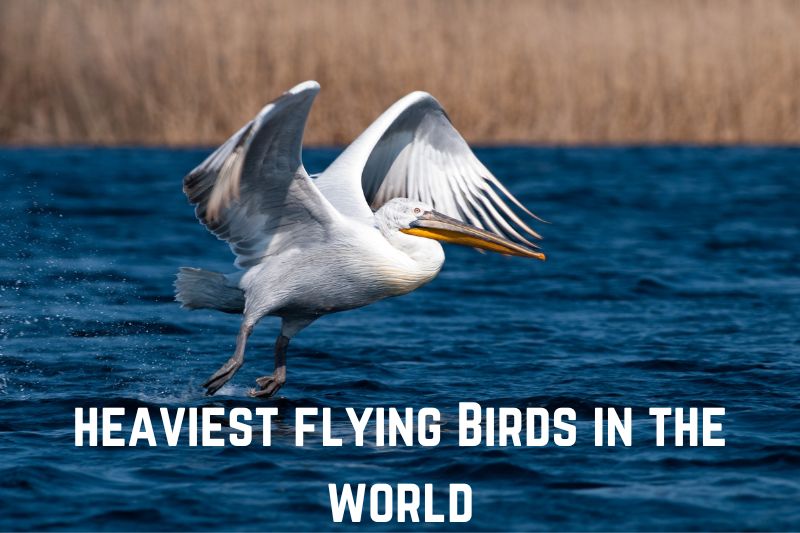Imagine looking up into the sky and seeing some of the world’s heaviest birds gliding effortlessly on the breeze. From vultures to pelicans, these impressive creatures defy gravity, despite their large size and heavy weight.
In this article, you’ll learn about 13 of the heaviest flying birds from around the globe, and marvel at their incredible feats of strength and endurance.
As you explore the fascinating world of these avian giants, you’ll discover diverse species with unique adaptations that allow them to conquer the skies.
While their weight may range anywhere between 15 and 44 pounds, these majestic creatures all share one common ability: the power of flight. Read on to learn about each bird’s distinctive features, habits, and habitats, as well as the incredible ways they achieve lift-off.
Get ready to be amazed by the sheer size and awe-inspiring beauty of these heavyweight champions of the sky. From the wandering albatross’s impressive wingspan to the powerful flight of the Andean condor, these birds demonstrate remarkable feats of strength and grace.
So, let’s take a closer look at these 13 heaviest flying birds in the world and uncover the secrets behind their astonishing aerial abilities.
Read: 11 Fascinating Animals With Long Faces
Contents
13 Heaviest Flying Birds in the World
1. Andean Condor

The Andean condor is a magnificent bird found in the Andes mountains and adjacent Pacific coasts of western South America. As one of the largest flying birds in the world, you’ll be amazed by its massive size, which can reach up to 33 pounds in weight and boasts an enormous wingspan of up to 10 feet 10 inches. In fact, it’s often considered the most enormous bird of prey globally [source].
Living in the high cliffs of the Andes Mountains, the Andean condor takes advantage of its extensive 10-foot wings to catch the rising warm air, enabling it to fly with minimal effort [source]. While roaming the skies, these majestic birds use their keen eyesight to search for food, primarily consisting of carrion.
As an Old World vulture, the Andean condor plays a vital role in maintaining a healthy environment by removing dead animals and preventing the spread of disease. Additionally, these condors have fascinating adaptations, such as their bald heads, which allow them to keep clean while feeding on carrion [source].
Your journey to explore the world’s heaviest flying birds wouldn’t be complete without learning about the Andean condor’s incredible ability to fly without flapping its wings.
Research has unveiled that these massive birds can stay airborne for hours while barely flapping, relying on updrafts and their immense wingspans to keep them aloft [source].
2. Dalmatian Pelican

As you explore the list of the world’s heaviest flying birds, you’ll come across the Dalmatian Pelican, which is one of the largest flying bird species. This fascinating bird belongs to the Pelecaniformes family and can be found in parts of Europe and Asia.
The Dalmatian Pelican weighs between 23.5 and 29 pounds (10.5 to 13 kilograms) with an impressive wingspan that ranges from 10.1 to 11.3 feet (310 to 345 centimeters).
The Dalmatian Pelican boasts a unique appearance with its curly feather crests, a pouch hanging beneath its beak, and large, webbed feet. This bird is well-adapted for life in wetland habitats, where it feeds primarily on fish (source).
These pelicans are known for their cooperation when it comes to capturing their prey. In groups, they work together to herd fish into shallow waters, making it easier for them to scoop up multiple fish at once with their large beaks.
The female Dalmatian Pelican even receives help from her male counterpart when gathering materials like twigs, grass, and algae for nest building (source).
Although this bird has a lifespan of 15 to 25 years in the wild, it can live up to 54 years in managed care. As of now, the Dalmatian Pelican is listed as vulnerable, which emphasizes the importance of conservation efforts to protect their populations and habitats.
3. Kori Bustard

Meet the Kori Bustard, one of the heaviest flying birds in the world. Found in Eastern and Southern Africa, these impressive birds have a weight range of 24-42 pounds (11-19 kilograms) and an expansive wingspan of 7.5-9 feet.
It might surprise you to know that Kori Bustards spend the majority of their lives on the ground. They are reluctant to fly unless they perceive a serious threat to their safety. This behavior is due in part to their considerable weight, which makes flying more energy-intensive.
An interesting fact about Kori Bustards is their unique method of drinking water. Unlike most birds that scoop water with their beaks, Kori Bustards use a sucking motion to drink, making them one of only a few bird species to do so.
Due to their size and ground-dwelling nature, Kori Bustards can be challenging to find in the wild. When you do encounter them, though, you’re sure to be in awe of their weight, wingspan, and distinctive appearance.
4. Great White Pelican

The Great White Pelican is an impressive bird that you may encounter in Africa and some parts of Europe and Asia. Known for its large size and distinct appearance, it ranks among the heaviest-flying birds in the world.
It has a wingspan of up to 3.6 m (11.8 ft) and can weigh up to 10 kg (22 lb), which makes it an awe-inspiring sight to behold.
As you observe this magnificent bird, you’ll notice its large, white body with black flight feathers and a massive yellow gular pouch that can hold up to 13 liters of water, or up to 4 kg of fish. Its black legs and webbed feet showcase its superb aquatic abilities, while the long, pointed bill allows it to effectively catch its prey.
You’ll find these birds often residing in shallow swamps, taking part in cooperative fishing. Groups of Great White Pelicans work together to create a circle around schools of fish, forcing them toward the shallow waters where they can easily scoop them up using their gular pouches.
The birds will then drain the water from their pouches and swallow the captured fish whole.
Aside from their fishing prowess, these birds are known for their exceptional flying abilities. Their massive wings enable them to fly long distances in search of food and nesting sites. It’s not uncommon to see them soaring gracefully through the sky during migration periods.
During your birdwatching adventures, don’t miss the opportunity to witness the Great White Pelican in action, as it showcases a testament to the remarkable variety and adaptability of the world’s heaviest flying birds.
5. Wandering Albatross

The Wandering Albatross is a fascinating bird, known for its impressive size and remarkable range. As one of the heaviest flying birds in the world, it can weigh up to 22 pounds (10 kilograms) and boasts the greatest known wingspan of any living bird, measuring between 8.2 and 11.8 feet (250-360 centimeters).
Your curiosity about these magnificent creatures may lead you to wonder about their habitat. Primarily found throughout the oceans in the Southern Hemisphere, the Wandering Albatross is an incredibly far-ranging bird.
As you learn more about this species, you’ll discover that they have adapted to life on the open sea and can spend a majority of their time soaring over the ocean’s vast expanses.
A few more interesting facts about the Wandering Albatross include:
- Part of the Diomedeidae family, which consists of large seabirds.
- Frequent long-distance travelers, capable of covering vast distances with minimal effort.
- Highly efficient gliders, using their large wingspan to take advantage of wind currents and updrafts.
Unfortunately, these majestic birds are under threat due to harmful fishing techniques and predation by invasive species. As a result, many albatross species are endangered or at risk. Raising awareness about the Wandering Albatross and its fascinating characteristics can help contribute to ongoing conservation efforts, ensuring these incredible creatures continue to grace our skies for generations to come.
6. Mute Swan

As one of the heaviest flying birds in the world, the Mute Swan is an impressive sight. Appearing in both Europe and Asia, these majestic creatures are known for their elegant white feathers and curved necks.
You might be surprised to learn that the male Mute Swan, also known as a cob, can weigh between 20 and 32 pounds, while the slightly smaller female, called a pen, can weigh from 18.7 to 21.3 pounds. These swans have a wingspan that can reach up to 7.8 feet, making them powerful flyers despite their hefty size.
When it comes to their habitat, Mute Swans prefer wetlands and can often be spotted gracefully swimming in ponds or rivers. In addition to their beauty, these birds are known for their signature low-pitched hissing calls, in contrast to the loud trumpeting sounds made by the closely related Trumpeter Swan.
Below are some key facts about the Mute Swan:
- Habitat: Wetlands across Europe and Asia
- Weight: Males (cobs) – 20 to 32 pounds, Females (pens) – 18.7 to 21.3 pounds
- Wingspan: Up to 7.8 feet
- Call: Low-pitched hissing sound
When you encounter a Mute Swan, take the time to appreciate their majestic beauty as well as their impressive size and strength. Remember, these magnificent birds are just one of the many fascinating heavy flying birds that share our world.
7. Trumpeter Swan

If you’re interested in one of the heaviest flying birds in North America, look no further than the Trumpeter Swan. With its beautiful white plumage and trumpet-like call, this elegant bird symbolizes grace and beauty as it glides through wetlands in North America.
As the largest waterfowl species native to North America, Trumpeter Swans can weigh up to 35 pounds and are among the heaviest flying birds in the world (American Bird Conservancy).
Read: 10 Stunning Birds With Green Feathers
Not only are they impressive in weight, but they also have a wingspan measuring between 4 ft 6 in and 5 ft 5 in (Wikipedia). So, it’s safe to say that their presence in the air is quite majestic!
When it comes to their habitat, Trumpeter Swans favor wetlands in forested regions. However, they were once common on northern prairies too (Audubon Field Guide). Due to conservation efforts, their population has made a significant comeback after nearly facing extinction early in the 20th century.
Some quick facts about Trumpeter Swans to remember include:
- Habitat: wetlands in North America
- Weight: up to 35 pounds
- Distinctive trumpet-like call
8. Whooper Swan

Whooper Swans are majestic migratory birds that are amongst the heaviest flying birds in the world, weighing about 30.8 pounds. They have a sizeable wingspan, which can reach up to 9 feet, providing them with the power to travel long distances at higher altitudes.
Originating from Eurasia, the Whooper Swan can also be found along North America’s west coast. As you observe these birds, you’ll notice that they resemble their close relatives, the trumpeter swans. Both species are vocal birds with a similar call, which makes them even more interesting to bird lovers.
The Whooper Swan’s habitat includes wetlands, lakes, and slow-flowing rivers. They are particularly fond of shallow waters with abundant vegetation.
In addition to their impressive size and flight capabilities, these swans also have a diverse diet. They feed on a variety of aquatic plants, as well as grasses, grains, and even occasionally small fish.
During breeding season, Whooper Swans form monogamous pair bonds and build large nests close to the water’s edge. Their eggs are quite large, contributing to the overall weight of these remarkable birds.
9. Marabou Stork

The Marabou Stork is a large wading bird that can be found in various regions of Africa, including tropical Africa, Senegal, Eritrea, Ethiopia, Somalia, Namibia, and South Africa. Its unique appearance, characterized by a bald head and enormous bill, makes it a fascinating bird to learn about.
As the largest member of the Ciconiidae family, the Marabou Stork can reach a height of 4.99 feet (152 centimeters) and a weight of up to 20 pounds (9 kg), making it one of the heaviest flying birds in the world. Its wingspan is equally impressive, measuring up to 12 feet (3.7 meters), and ranks as the largest among living birds.
Your Marabou Stork primarily thrives in wet and arid areas around the Sahara Desert. Its diet consists mostly of carrion and waste, making it an important scavenger in its ecosystem. Keep in mind that the Marabou Stork’s feeding habits also contribute to its nickname, “the undertaker bird”.
Here are some facts about the Marabou Stork:
- Habitat: Sub-Saharan Africa
- Weight: up to 20 pounds (9 kg)
- Diet: primarily scavengers, feeding on carrion and waste
- Wingspan: up to 12 feet (3.7 meters)
With this information on the Marabou Stork, you can now appreciate its incredible size and its important role in its environment.
10. Greater Rhea

The Greater Rhea is a large South American bird that roams the open pampas and sparse woodlands of Argentina and Brazil. As one of the heaviest flying birds in the world, Greater Rheas can weigh up to 15 pounds.
You might be curious about this bird’s flight. Although Greater Rheas are considered flightless due to their size and relatively short wings, they can still run at impressive speeds, reaching up to 37 miles per hour. This makes them adept at escaping predators and navigating their native habitats.
Let’s take a look at some distinct characteristics of the Greater Rhea:
- Height: up to 4.9 feet
- Wingspan: 6.2 to 8.2 feet
- Life span: 10 to 15 years
- Diet: Omnivorous – plants, seeds, fruits, insects, and small vertebrates
Another fascinating aspect of Greater Rheas is their breeding behavior. Males play an integral role in nesting and caring for their young. After building a nest, the male mates with multiple females who then deposit their eggs in the nest. The male incubates the eggs and takes full responsibility for raising the chicks once they hatch.
In conclusion, the Greater Rhea is a remarkable bird that showcases impressive size and unique breeding habits among the heaviest flying birds in the world. Keep this intriguing creature in mind as we continue exploring other notable heavyweights in the avian world.
11. Emperor Penguin

When you think of large birds, the Emperor Penguin might not be the first one to come to mind. However, it is certainly one of the heaviest birds, weighing between 22 to 45 kg (49 to 99 lb) and reaching a height of around 100 cm (39 inches) [Wikipedia]. Endemic to Antarctica, these birds have adapted to thrive in harsh polar conditions.
In comparison to other penguins, the Emperor Penguin is the tallest and heaviest of all living species [National Geographic]. Although they aren’t capable of flying due to their hefty mass, they still have impressive aquatic abilities.
Emperor Penguins can dive up to 1,850 feet deep (564 meters) and hold their breath for more than 20 minutes while hunting for prey.
One fascinating aspect of Emperor Penguins is their breeding behavior. The male takes care of the egg by balancing it on top of his feet for two months during the harsh Antarctic winter, while the female goes hunting for food.
Once the chick hatches, the male and female take turns foraging for food and bringing back meals in their stomachs to regurgitate for their offspring.
Despite their inability to fly, Emperor Penguins play a vital role in the Antarctic ecosystem. As predators, they help maintain a balance in the food chain.
In turn, they are also prey for other Antarctic predators such as Leopard Seals and Killer Whales. As a result, their existence is crucial for the delicate balance of the southernmost continent’s ecological systems.
12. African Crowned Crane

The African Crowned Crane is a remarkable bird that you might want to know about. These large, long-legged birds are characterized by straight bills and long necks. Their elevated hind toe and striking appearance make them a sight to behold.
One of the most distinguishing features of the African Crowned Crane is the golden feathery ‘crown’ protruding from the back of its head. This, combined with bare pink or red and white cheek patches, creates a truly unique appearance. You’ll also notice their predominantly slate gray color, with dark gray to black primary and secondary feathers that have chestnut markings.
The African Crowned Crane is also known as the West African Crowned Crane or the black crowned crane, and it is the national bird of Nigeria. These beautiful birds can be found in various regions across Africa, making them an essential part of the continent’s diverse birdlife.
Here’s a quick overview of the African Crowned Crane’s characteristics:
- Weight: 7 – 12 pounds (3.2 – 5.4 kg)
- Height: 39 – 43 inches (100 – 110 cm)
- Wingspan: 6.2 – 6.6 feet (190 – 200 cm)
- Habitat: Wetlands, grasslands, and savannas
- Diet: Omnivorous, including insects, small mammals, and plant matter
In addition to their impressive size and distinctive appearance, the East African Crowned Crane is known for its elegant courtship dance. This unique ritual involves bowing, head pumping, and leaping, making it a fascinating sight for birdwatchers and wildlife enthusiasts.
With their striking features, graceful movements, and significant role in African birdlife, the African Crowned Crane is undoubtedly a noteworthy member of the heaviest flying birds in the world.
Read: 11 Most Dangerous Animals in Mexico
13. Lesser Adjutant

The Lesser Adjutant is another impressive flying bird you might be interested in learning about. This heavy bird, native to Asia, can weigh up to 14 pounds (6.3 kg) and has a wingspan reaching 8.2 feet (2.5 meters).
Lesser Adjutants are part of the stork family and are known for their distinct appearance. They have a bald head, a large bill, and a warty yellow-orange neck. Their large, broad wings make it easier for them to soar through the sky.
These birds typically inhabit wetlands, swamps, and other areas close to water. They feed on various aquatic creatures such as fish, frogs, and crustaceans. Their unique foraging technique involves standing motionless in shallow waters and suddenly grabbing their prey.
As with most large birds, the Lesser Adjutant’s population is under threat due to habitat loss and pollution. Conservation efforts are being made to protect their nesting sites and raise awareness about preserving their natural habitats. You can help by supporting organizations that work to conserve wetlands and protect these amazing birds.







